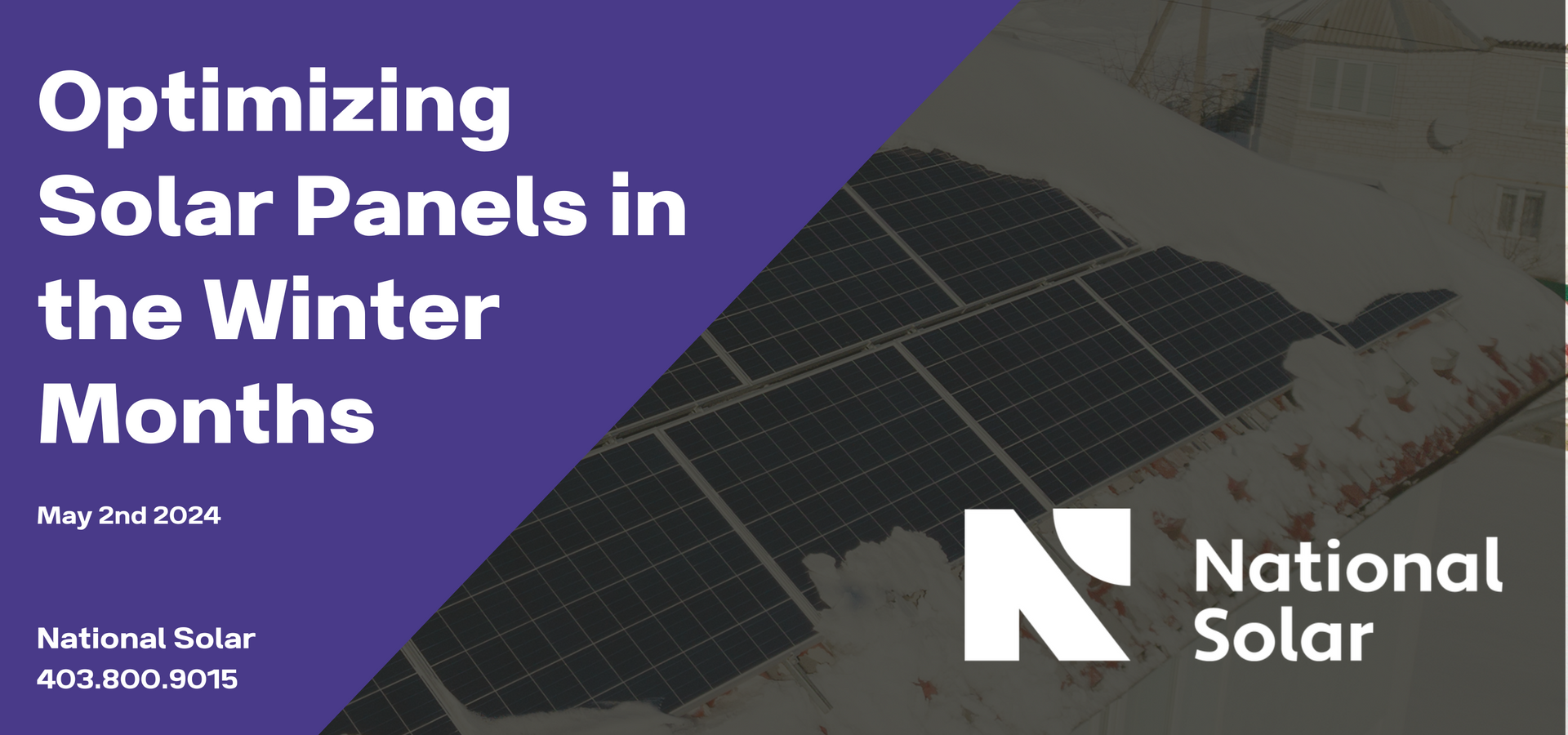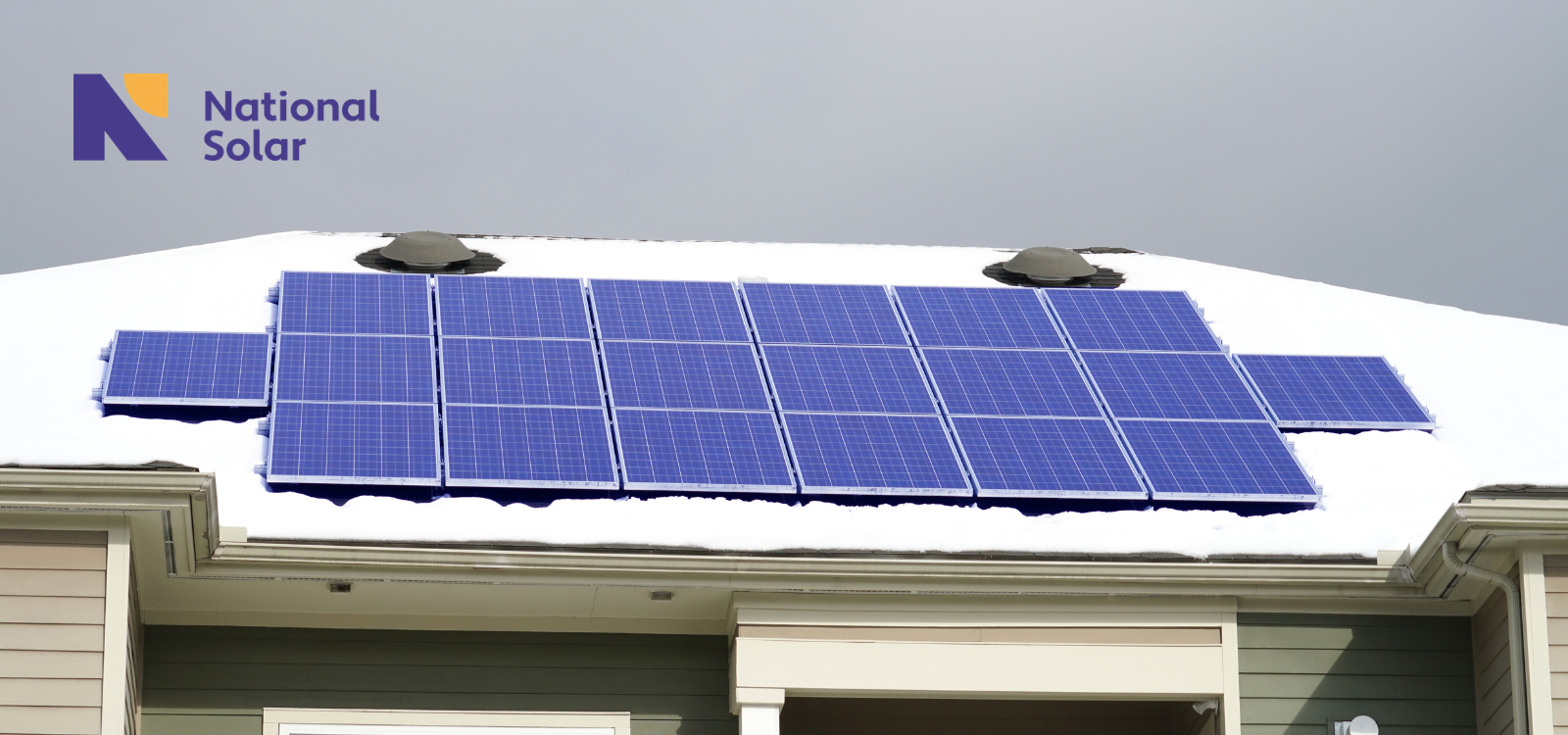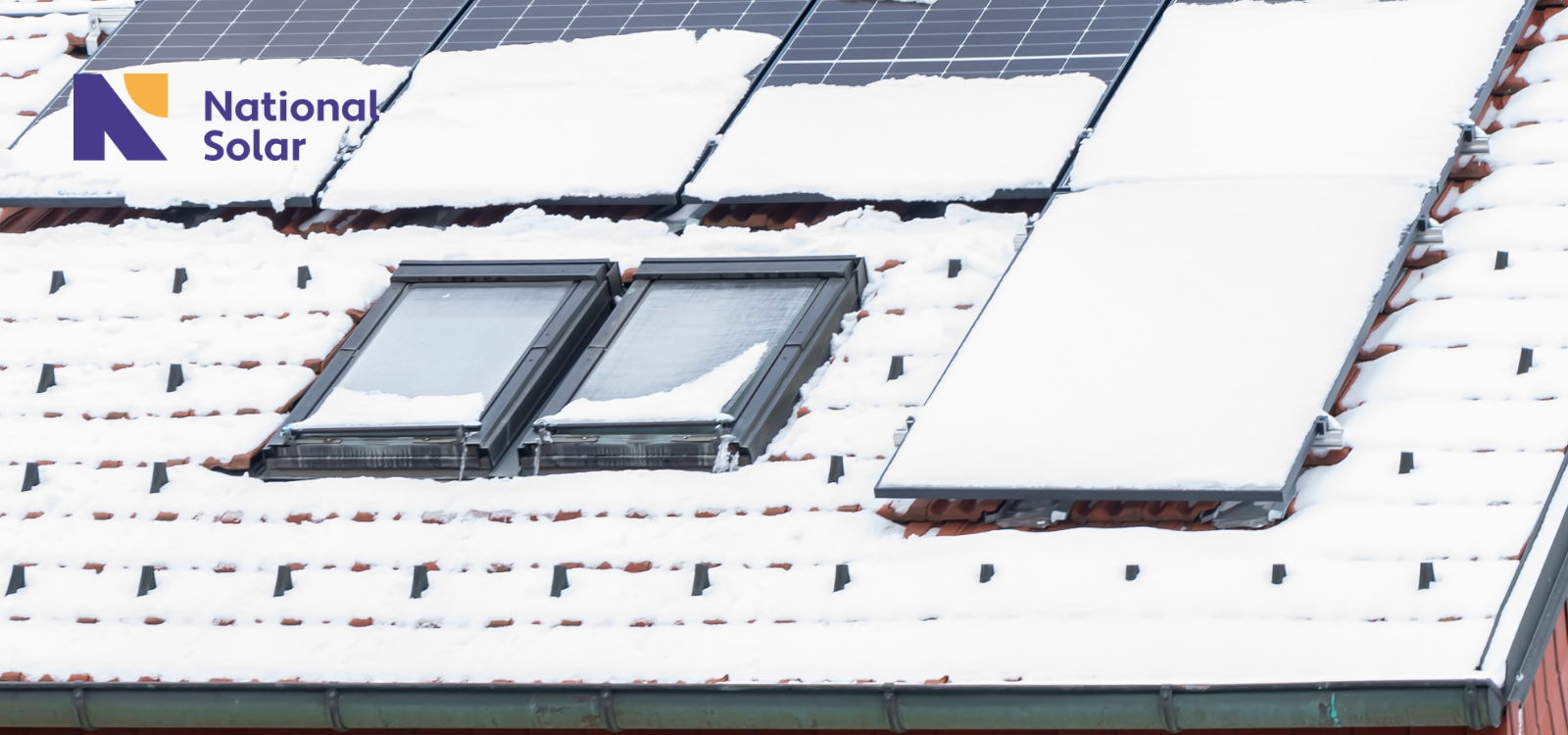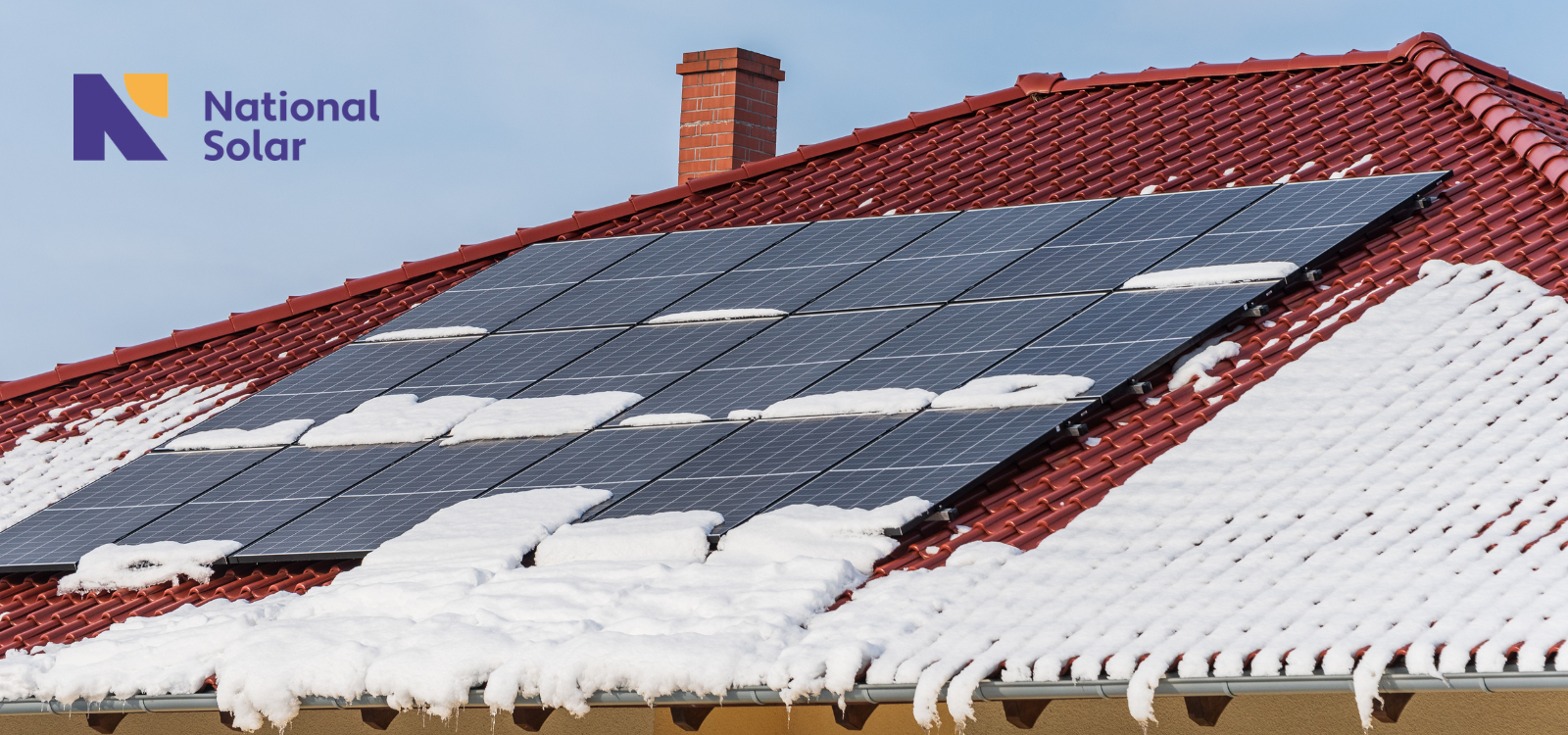Optimizing Solar Panels in the
Winter Months

Optimizing Solar Panels in the Winter Months
Do solar panels in the winter lose their spark under the weight of snow and shorter daylight hours? This concise guide dispels concerns about solar efficiency in the cold, discussing how solar panels can defy winter’s challenges to keep your lights bright and your energy costs down.
Key Takeaways
- Solar panels are efficient in cold weather
due to increased conductivity in silicon, which allows them to thrive and sometimes perform better than in hot temperatures.
- Proper maintenance and design, such as tilting panels and using snow guards, help solar panels to effectively shed snow and continue generating energy during winter.
- Shorter winter days pose a challenge for solar energy capture, but this can be mitigated with the right strategies like adjusting panel angles and utilizing MPPT technology to maximize efficiency.
Harnessing Winter Sunlight: How Solar Panels Thrive in Cold Weather
Contrary to popular belief, solar panels maintain functionality, and in some cases, can even improve performance during winter conditions. Surprisingly, it’s not the heat but the sunlight that solar panels crave. They perform admirably even in colder climates, debunking the myth that solar panels perform only optimally in hot conditions.
The secret to their winter prowess lies in their design and the unique properties of silicon, the primary material used in solar panels. As the mercury drops, electron movement in silicon increases, boosting conductivity. This means that even in freezing temperatures, as long as they are exposed to sufficient sunlight, solar panels can efficiently produce electricity.
The Science of Cool: Why Solar Cells Prefer the Cold
Contrary to popular belief, solar panels maintain functionality, and in some cases, can even improve performance during winter conditions. Surprisingly, it’s not the heat but the sunlight that solar panels crave. They perform admirably even in colder climates, debunking the myth that solar panels perform only optimally in hot conditions.
This might seem counter intuitive, but with every drop in temperature, solar panels inch closer to their peak performance, often achieving or even exceeding their estimated output. So, the next time you see a solar panel basking in the winter sun, remember that it’s not just surviving - it’s thriving!
Ensuring Energy Flow: How Cold Climates Affect Solar Panel Performance
The ability of solar panels to perform better in cold weather is largely due to the enhanced conductivity of their materials. When it gets cold, the electric current in solar panels improves, leading to a higher energy yield and increased solar panel efficiency.
This increased conductivity in colder temperatures helps ensure a steady flow of energy from the panels. Even when Jack Frost is nipping at your nose, your solar power system is working hard, converting sunlight into electricity and powering your home.
Winter's Silver Lining: Reduced Overheating Risks
Just like us, solar panels can get a bit too hot during the summer. Overheating can lead to decreased panel efficiency, but here’s where winter comes to the rescue. The cooler temperatures significantly reduce the risk of overheating in solar panels.
So, while we humans bundle up to ward off the winter chill, solar panels bask in the cold, enjoying enhanced performance. If you think about it, winter isn’t just a season of snowflakes and hot cocoa; for solar panels, it’s a season of power-packed performance!

Navigating the Snowy Challenges: Keeping Your Solar Panels Clear
Winter, with its majestic snowfall and frosty charm, does pose certain challenges for solar panels. Snow accumulation can block sunlight and put stress on panels’ mounting points. Ice buildup can even stop them from working properly and potentially cause cracking and fracturing.
However, these issues are manageable. With the right design and proper maintenance, solar panels can effectively shed snow and continue to generate power throughout the winter. In fact, a well-maintained solar panel can turn a snowy challenge into a winter wonderland of energy generation.
Snow Shedding and Solar Design
The design of solar panels plays a vital role in their ability to handle snow. Most solar panels are installed with a slight tilt, which facilitates natural snow shedding and reduces buildup that could block sunlight.
This tilt, combined with the slippery surface of solar panels, makes it difficult for snow to stick around for long. Plus, snow guards can be added during installation to control snow accumulation, especially in areas with significant snowfall. So, even when snowflakes are falling, your solar panels are designed to keep the energy flowing.
The Art of Snow Removal: Techniques for Clearing Panels
When winter throws a snowball at your solar panels, how you respond can make all the difference to their performance. While light snow tends to melt quickly and can even clean the panels, heavy snowfall needs to be managed.
Encouraging natural snow melting is a safe way to clear solar panels and ensure minimal risk of damage. But in cases where the snow just doesn’t want to budge, you might need to take matters into your own hands. Using a soft snow brush can prevent scratches and damage to the panels during manual clearing. And when the natural melting isn’t an option, it’s time to call in the specialists.
Specialized solar snow removal services can safely clear your panels, ensuring they’re ready to soak up the sun once more.
Letting Nature Do the Work: The Benefits of Passive Snow Melt
Despite the hurdles, winter brings its own unique advantages for solar panels. Thanks to their dark surface, solar panels naturally absorb sunlight, which heats them up and aids in the melting of snow.
Even with a light layer of snow, solar panels are still capable of generating electricity. Yes, their efficiency may be somewhat reduced, but remember – a snow-covered solar panel generating some power is better than a covered panel generating no power at all.

Solar Power System Efficiency During Shorter Daylight Hours
While solar panels have a knack for thriving in the cold, winter does present one significant challenge - reduced sunlight exposure. Shorter daylight hours and the sun’s lower position in the sky mean that solar panels encounter reduced exposure to sunlight.
But don’t despair just yet. Despite these challenges, there are strategies to optimize your solar power system’s efficiency during these shorter winter daylight hours. Let’s shed some light on these strategies.
Making Every Hour Count: Strategies to Maximize Winter Sun Exposure
To maximize sunlight capture during winter, you can adjust the angle of your solar panels. A steeper tilt angle can improve their electricity generation capability and help with snow shedding.
Solar tracking systems also come in handy. These systems follow the sun’s path across the sky, significantly increasing energy capture. They prove particularly beneficial in the winter months due to the sun’s varied path. With these strategies, you can ensure your solar panels soak up every possible ray of sunshine, even on the shortest winter day.
Smart Technology for Low Light: Enhancing Performance with MPPTs
Smart technology has a role to play in overcoming the winter daylight challenge. Maximum Power Point Tracking (MPPT) is a method used to optimize the efficiency of solar panels by mitigating power losses during rapid changes in irradiance conditions.
The
Victron Energies MPPT
technology offers the following benefits:
- Maximizes power generation from solar panels, especially in low-light situations
- Specifically tailored to improve power harvesting in low-light conditions
- Advanced MPPT algorithms allow solar panels to handle the variability of solar irradiance
- Better performance, especially during partial shading conditions

Preparing Your Solar Array for Winter Conditions
Just like you winterize your home or your car, your solar array needs some prep work for winter too. Tailored winter maintenance is crucial for ensuring that solar panels last longer and operate more efficiently.
Whether it’s adjusting the tilt angle of your panels or maintaining the solar batteries, taking these steps can ensure your solar array is winter-ready and set to generate power even during the frostiest months.
Seasonal Adjustments: Fine-Tuning Your Solar Installation for Winter
Fine-tuning your solar installation for winter can significantly improve its performance. Adjusting the tilt angle of solar panels to a steeper position during the winter months can improve their electricity generation capability and help with snow shedding.
In fact, for optimal year-round performance, solar panels should be set at an angle close to the latitude of the installation location, with consideration for seasonal variations. So, by making a few tweaks, you can ensure your solar installation is fine-tuned for the frosty season.
Regular Maintenance Matters: Why Upkeep is Key in Cold Climates
Solar panels are sturdy, but they still need some TLC, especially in winter. Solar panels require maintenance, and regular checks are essential for them to operate at peak efficiency during winter months.
Performing regular cleaning after snowfalls ensures that panels can absorb the maximum amount of sunlight and prevents staining and damage to the mounting hardware. While melting snow can naturally clean solar panels, it should not be solely relied upon for solar panel maintenance.
Protecting Your Investment: Insulation and Care for Solar Batteries
Your solar panels are only half of the equation. To ensure your solar power system operates at its best during winter, you need to pay attention to your solar batteries too. They require proper insulation during the winter to ensure optimal performance.
Solar batteries:
- Should be stored indoors or well-insulated if kept outdoors, as they are not designed for very low temperatures.
- Require monitoring of the temperature to maintain them within optimal operational ranges.
- Should not be completely discharged. Recommended levels are around 50% to prevent excessive wear during high usage in winter.

Renewable Energy Benefits in the Frosty Season
The benefits of solar panels extend beyond energy production. Even in winter, solar panels continue to provide environmental benefits, contributing to:
- Reduced greenhouse gas emissions
- Energy independence, reducing reliance on traditional energy sources
- Financial savings, particularly when traditional fuels become more expensive during the colder months.
Let’s delve a little deeper into these benefits.
Clean Energy All Year Round: Solars Role in Reducing Carbon Footprint
Solar energy is a clean and renewable source that helps in reducing carbon emissions year-round. Even during the cold winter months, solar panels remain productive, bolstering efforts to minimize the global carbon footprint by maintaining a consistent solar energy output.
Beyond environmental benefits, the growth of the solar industry fosters economic development by generating new jobs and business opportunities. This makes solar panels not just a choice for sustainable energy but also a driver of economic growth.
Energy Independence in Unpredictable Weather
Solar panels, which consist of solar panel photovoltaic cells, offer a degree of energy autonomy, reducing reliance on the electrical grid. Solar panels produce electricity, making solar panel systems particularly beneficial during winter, when unpredictable weather can cause fluctuations in traditional power sources.
So, whether it’s a blizzard or a snow shower, with solar panels, you have the assurance of a steady power source. And who doesn’t love a bit of independence, especially when it comes to energy?
Financial Savings When Temperatures Drop
The benefits of solar panels include:
- Environmental benefits
- Energy independence
- Financial savings, as solar panels can lead to reduced energy costs in winter when traditional fuels typically become more expensive.
Solar panel owners can even use credits accrued from excess energy production during the summer to save on winter electricity bills. So, despite lower output potential during winter storms, solar panels still yield financial savings by lessening dependence on pricier traditional energy sources.
Summary
To sum it up, solar panels are more than capable of facing the frosty challenges of winter. With the right installation, maintenance, and smart technology, they can operate efficiently, even in colder climates. They offer environmental, energy independence, and financial benefits, making them a viable energy source all year round. So, when the temperatures drop, remember - your solar panels aren’t just surviving the winter, they’re thriving in it!
Frequently Asked Questions
Do solar panels work in cold weather?
Yes, solar panels can work and even perform better in cold weather due to enhanced conductivity of their materials.
How can I optimize my solar panel efficiency in winter?
To optimize your solar panel efficiency in winter, consider adjusting the tilt angle, using solar tracking systems, and employing smart technology like MPPT for better performance. Try these solutions for improved results.
Do solar panels require special maintenance in winter?
Yes, regular maintenance checks and cleaning after snowfalls are essential for solar panels to operate at peak efficiency during winter. Solar batteries also need to be properly insulated and monitored. Be sure to keep up with these tasks to ensure optimal performance.
1. What happens to solar panels during snowfalls?
When snow covers solar panels, their ability to produce electricity is temporarily reduced. However, most panels are installed at an angle, which helps the snow to slide off more easily once the sun comes out or temperatures rise. Additionally, the panels' dark surfaces absorb heat from the sun, further aiding in melting the snow.
2. Can freezing temperatures damage solar panels?
Solar panels are built to withstand various weather conditions, including extreme temperatures. Freezing temperatures alone typically do not damage solar panels. They are designed to endure such environmental stressors, ensuring durability and functionality even during very cold weather.
3. Will shorter daylight in winter decrease solar energy production?
While it's true that there are fewer daylight hours in winter, solar panels can still effectively produce energy, albeit at reduced levels compared to summer. The actual impact on energy production varies by location, with areas closer to the equator experiencing less variation in daylight hours throughout the year. Advances in solar technology also help maximize light absorption and efficiency during these shorter days.


